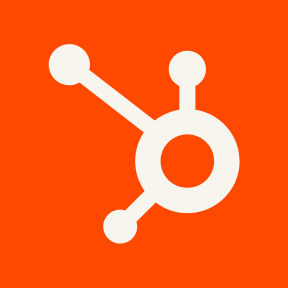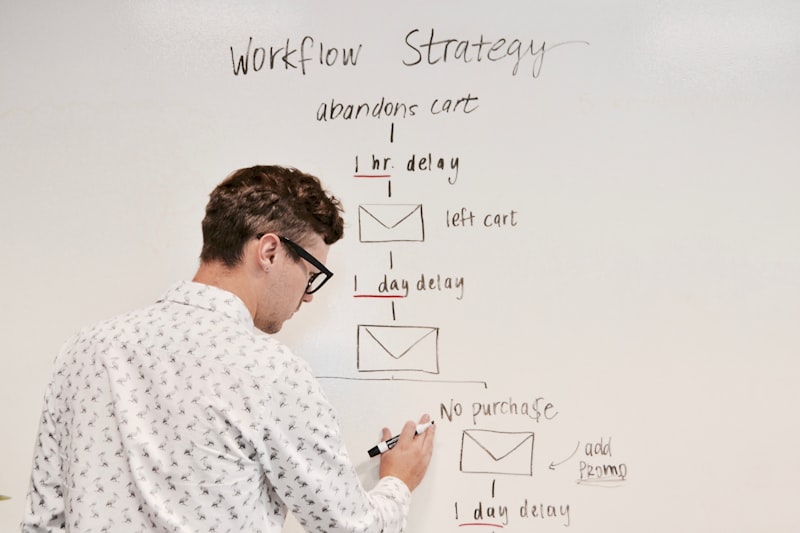"Promotions properly timed to seasons can achieve up to 7x greater success."
As a travel marketer, I know first-hand how competitive our industry is. Standing out in crowded inboxes while inspiring wanderlust is no easy feat. But that’s why I’m so passionate about email marketing - when done right, it’s one of the most effective ways to engage travelers and drive conversions.
I live for those winning campaigns that completely captivate customers. You know, the ones that speak right to their deepest travel desires? I love when a brilliantly designed email comes together with smart personalization and stops readers mid-scroll thinking “Yes, this is the trip I’ve been waiting for!”
That emotional click is my ultimate goal.
In this guide, I’ll dig into the latest email innovations and best practices that can help travel brands create those high-impact campaigns. Trust me, I’ve tested a lot of strategies in my career. These four areas have shown the most promise in sending open rates soaring:
- Personalization
- Seasonal trends
- Visual content
- Measurement
Implement even a few of these tips, and you’ll be sure to grab attention in crowded inboxes and drive more travel dreamers to fulfill those bucket list adventures. I can’t wait to see the record engagement when you put some of this guidance into action!
The Importance of Personalization in Travel Emails
Personalization is one of the most powerful tools in a travel marketer’s toolkit. Research shows personalized subject lines alone can increase open rates by up to 50%.
Below are case studies of travel brands that generated stunning results from personalized email campaigns, along with tips you can implement today.

Email Personalization Playbook
This playbook provides actionable checklists, templates, and tips to help travel brands:
- Audit and segment their email lists
- Analyze customer data
- Map detailed subscriber profiles
- Ideate hyper-relevant content
- Test tailored subject lines
Follow this guide to take your email personalization to the next level!
Conduct an Email List Audit
🚧 Assess your current email subscribers
- How many total subscribers do you have?
- How fast is your list growing?
- What onboarding/welcome flows do you have in place?
🚧 Review key subscriber metrics
- Open rates: _______
- Click-through rates: _______
- Unsubscribe rate: _______
🚧 Identify any list hygiene issues
- Inactive subscribers: Yes/No
- Bounced/undeliverable emails: Yes/No
- Spam complaints: Yes/No
Segment Your Email List
🚧 Brainstorm segmentation approaches
- Demographic data
- Past purchases
- On-site behaviors
- Customer lifecycle stage
- Preferences/interests
- High-value groups
🚧 Prioritize variables for initial segmentation
🚧 Technical considerations
- Fields needed in CRM/email platform?
- Tags/custom fields to track?
- Automation setup?
Analyze Customer Data
🚧 Identify data sources
- CRM, email platform, analytics, surveys, etc.
🚧 Uncover insights
- Purchase histories
- Page views
- Email engagement
- Service interactions
- Loyalty status
- Reviews/feedback
🚧 Notable trends or common attributes?
Map Detailed Subscriber Profiles
🚧 Define 2-3 core subscriber personas
Persona 1: _______________________
Details:
Persona 2: _______________________
Details:
🚧 Build profile templates
Name:
Demographics:
Behaviors:
Interests:
Travel goals:
Values:
Motivations:
Other:
🚧 Populate with example profiles
Profile 1
Profile 2
Profile 3
Ideate Segmented Content
🚧 Brainstorm content ideas tailored to personas
Persona 1 ideas:
Persona 2 ideas:
🚧 Collaborate across teams
- Email team
- Product marketing
- Content teams
- Designers
🚧 Prioritize concepts
Test Subject Line Personalization
🚧 Create 2-3 subject line variations per template
Template 1:
- Variation 1
- Variation 2
- Variation 3
Template 2:
- Variation 1
- Variation 2
- Variation 3
🚧 Send to small test segments
- Version A: 50 contacts
- Version B: 50 contacts
🚧 Compare open & click-through rates
- Version A: __% open rate, __% CTR
- Version B: __% open rate, __% CTR
🚧 Apply learnings in future campaigns
Case Studies: Successful Personalized Email Campaigns
EasyJet
When European airline EasyJet started personalizing flight alert emails with customer names, open rates increased 32% and click-through rates doubled.
Vail Resorts
Ski resort company Vail Resorts knows its customers need hyper-targeted information. By personalizing emails based on visitor history and preferences, Vail boosted email revenue by 183%.
JetBlue
JetBlue began adding customers’ TrueBlue account numbers to email subject lines. This simple personalization grew open rates by 100% and increased conversions by 15%.

Tips for Personalizing Your Travel Emails
How can you implement personalization across your own travel email campaigns? Here are five proven techniques:
- Use first names in subject lines and copy. This immediately catches attention.
- Reference past purchases or behaviors like recently viewed items.
- Tailor content based on customer personas and preferences.
- Leverage behavioral data around interests and habits.
- Segment your lists so messaging resonates. Personalize for families, business travelers, adventurers, etc.
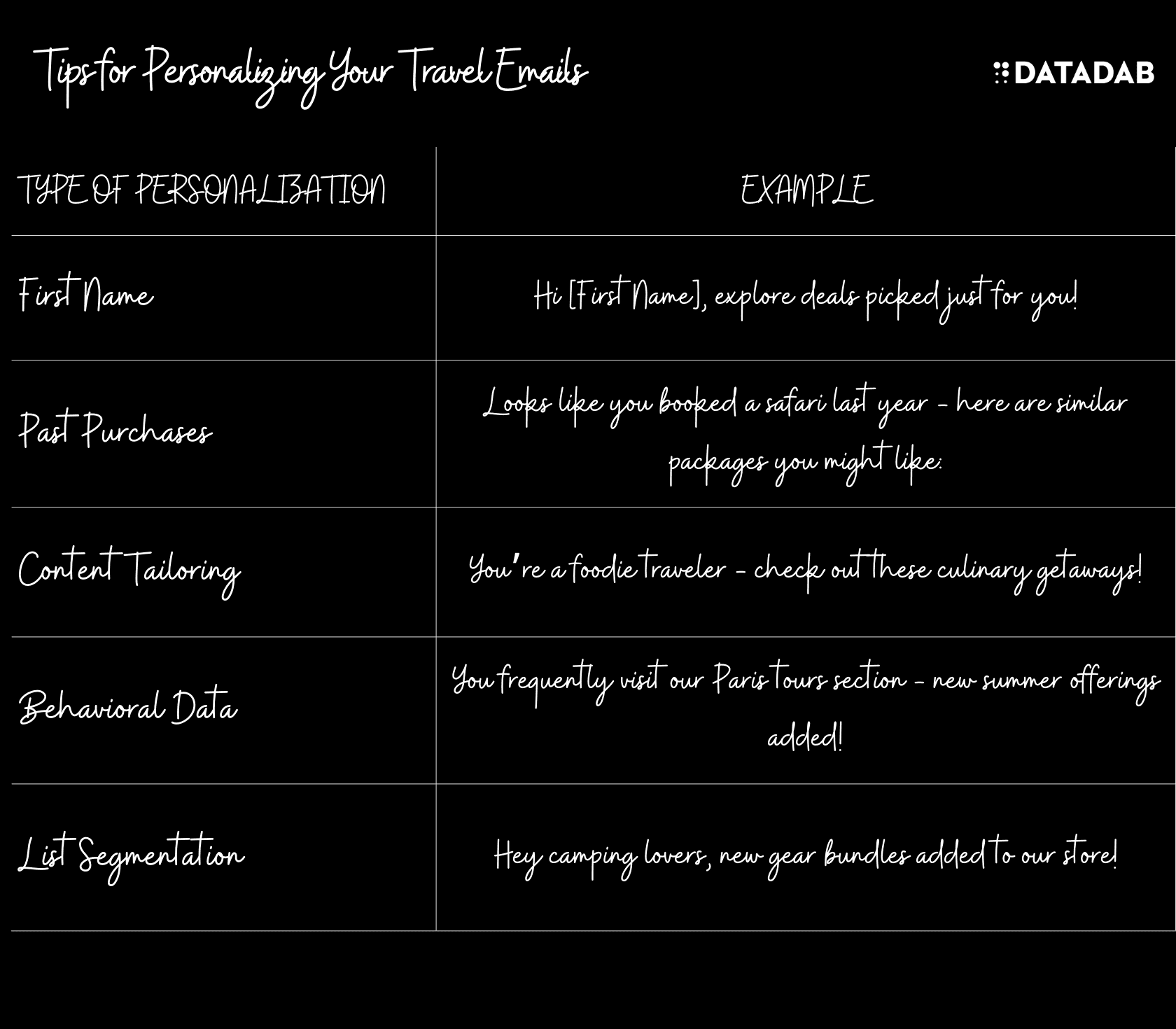
Well-executed personalization makes customers feel valued, understood, and catered to. Studies show 77% of consumers only engage with personalized messaging, so it’s clearly worth the investment.
Leveraging Seasonal Trends for Timely Promotions
Traveler interests fluctuate based on seasons and holidays. Aligning your email content calendar with timely themes and events allows you to deliver promotions when customers are most receptive.
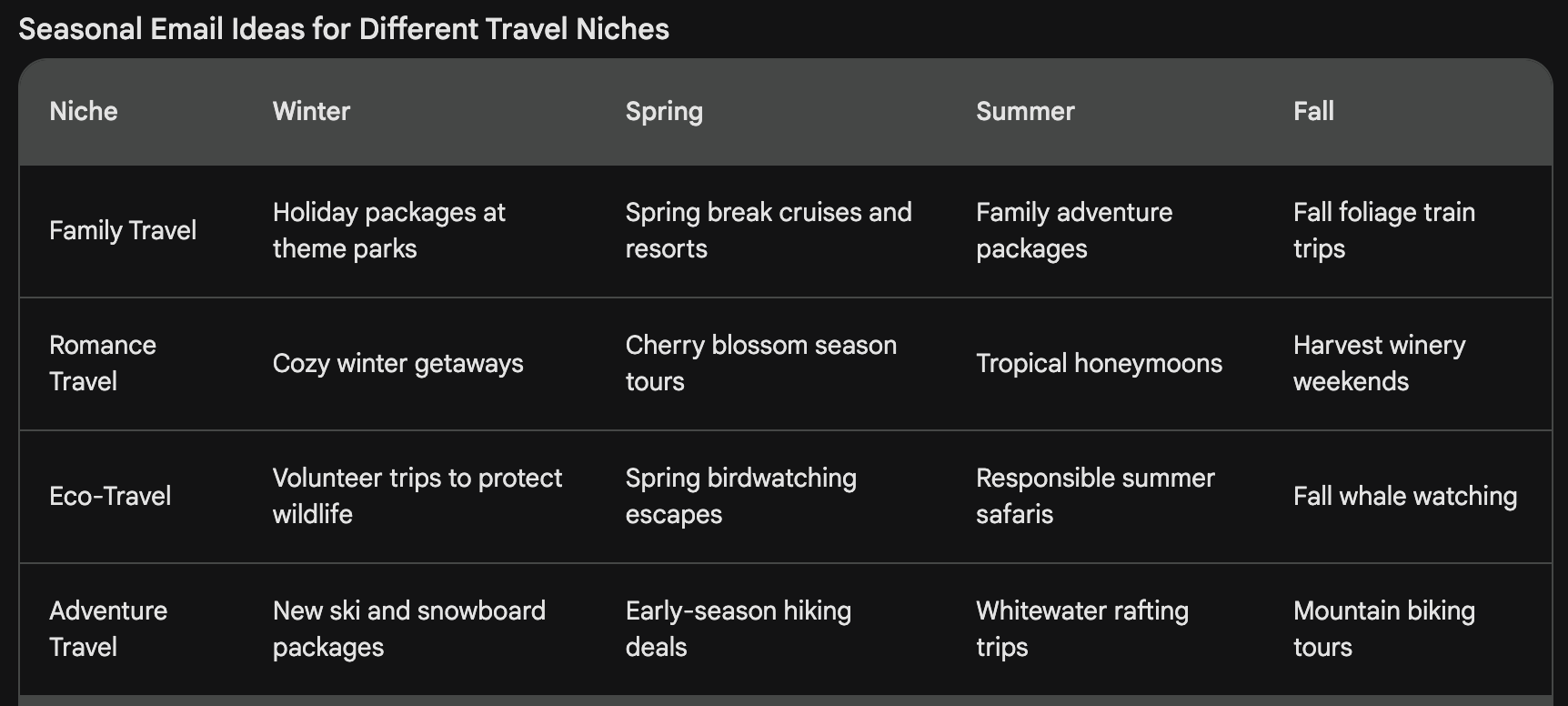
Identifying Key Travel Seasons
Pinpoint recurring seasonal travel patterns among your customers. Common high-demand periods include:
- Winter: skiing, winter holidays, warmer destinations
- Spring: spring break, Easter, romantic getaways
- Summer: beach vacations, family travel, outdoor adventures
- Fall: leaf peeping, harvest festivals, school breaks
Research your email performance analytics to see when your customers are most actively engaged throughout the year. Identify any seasonal surges or dips.
Crafting emails tailored to relevant seasonal interests will feel intriguing yet familiar, inspiring action.
Crafting Season-Specific Email Campaigns
With your key seasons mapped out, develop seasonal themes and travel deals to feature.
For winter, promotions may include:
- Ski packages at popular resorts
- December holiday getaways and gift ideas
- All-inclusive resort deals for families and couples
For spring, highlight:
- Spring break cruise deals
- Easter vacation destinations
- Outdoor adventure trips as weather warms
For summer, focus on:
- Family packages at amusement parks or dude ranches
- Beach vacation deals at hotels and resorts
- Road trip itineraries and recommendations
For fall, emphasize:
- Foliage tours and hiking trips
- Halloween/Thanksgiving packages
- Holiday getaway deals for late November/December
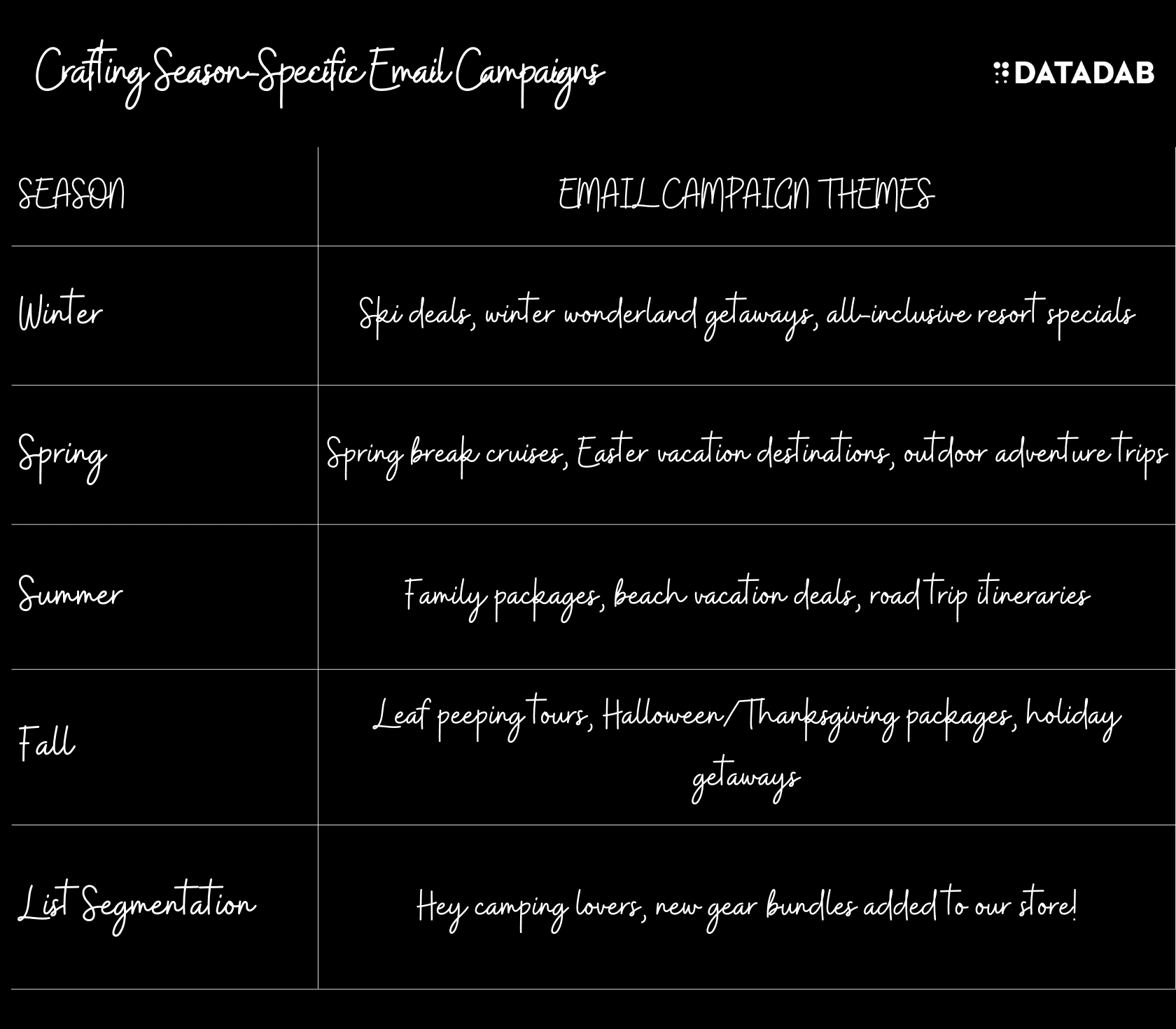
As you design seasonal campaigns, make your emails festive with relevant colors, imagery, and language conveying the excitement of the season.
Timely, seasonal emails perform up to 7x better than misaligned content. Follow this tip, and you’ll boost engagement all year long.
Travel Email Design Guide
Images
- [ ] Use high-quality destination photos that spark wanderlust 🏞️
- [ ] Hero images should transport readers to desirable locations ✈️
- [ ] Focus on travel activities and emotions vs static landscapes 📷
- [ ] Ensure images are relevant to email content and themes 🎯
- [ ] Format images for crisp rendering across devices 💻
- [ ] Optimize and compress images for fast load times ⚡️
- [ ] Include descriptive captions for greater context 💬
Layout
- [ ] Use clean, simple templates for visual hierarchy 📐
- [ ] Limit width and adopt single-column mobile-first design 📱
- [ ] Include ample white space between elements 💆
- [ ] Ensure strong visual contrast for engagement 👀
- [ ] Divide long content into easily scannable sections 👓
- [ ] List key details like dates and locations prominently 🗓️
Copy
- [ ] Communicate benefits and value clearly 🗣️
- [ ] Use descriptive headers and subheads 📜
- [ ] Align copy tone to travel brand personality 💭
- [ ] Focus on helping over heavy selling 🙅♂️
- [ ] Add specifics like dates, prices, and locations 📆
- [ ] Include relevant testimonials and social proof 👍
Calls-to-Action
- [ ] Strategically place CTAs in the visual flow 🔜
- [ ] Use contrasting colors to draw attention 🚦
- [ ] Communicate value and urgency ⏱️
- [ ] Keep CTA copy short and scannable 📝
- [ ] Link to specific landing pages 🔗
Mobile Optimization
- [ ] Preview on various screen sizes with a tool like Litmus 📱
- [ ] Use large, legible fonts and ample spacing 📖
- [ ] Limit content density above the fold 📏
- [ ] Stack elements vertically for single-column flow 📊
- [ ] Link CTAs to tap easily on mobile 👆
- [ ] Confirm fast image load times on mobile ⚡️
Integrating Stunning Visuals in Travel Email Campaigns
They say a picture is worth a thousand words. In email marketing, compelling visual content is invaluable for capturing attention in crowded inboxes.
Follow these best practices for selecting and designing visuals guaranteed to mesmerize subscribers.
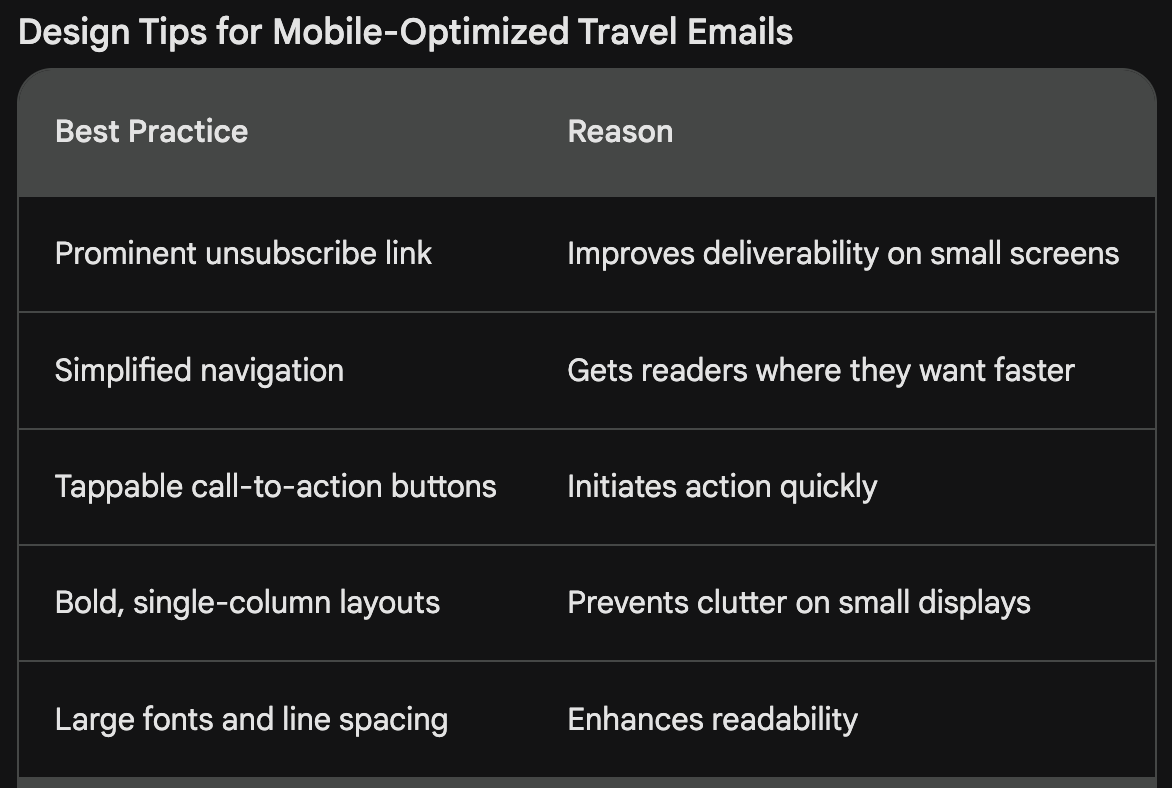
Best Practices for Image Selection and Design
Choose inspiring destination photos - Transport readers to stunning locales that spark wanderlust. Hero images should feel aspirational and intriguing.
Use enticing travel photography - Focus on people actively exploring to spur customers to imagine themselves there.
Feature eye-catching landscapes - Breathtaking vistas and natural wonders make alluring backdrops.
Pick crisp, vibrant images - Opt for high-resolution photos with vibrant colors that pop on screens.
Include descriptive captions - Complete the picture with details on what’s shown.
Add supporting graphics - Enhance imagery with infographics, illustrations, maps, etc.
Ensure proper sizing and formatting - Images should be sized appropriately without slowing load times. Use responsive design.
Provide clear calls-to-action - Use directional cues, strategic placements, and contrasting buttons that lead the eye.
Tools and Techniques for High-Impact Visuals
Take your visuals up a notch with these tools:
- Canva - Create stunning designs with custom templates, easy editing, and a huge image library.
- Pixlr - This free Photoshop alternative allows powerful yet user-friendly image editing and effects.
- Bannerbear - Easily design responsive banners and images scaled for all devices.
- Getty Images, iStock, Shutterstock - These sites offer diverse libraries of high-quality photographs.
- GIPHY - Search this database for entertaining GIFs to add a fun flair.
With compelling imagery aligned to seasonal themes and personalized content, your emails will transport customers to their next great adventure.
Measuring Success: Key Metrics in Travel Email Marketing
To refine your approach, closely monitor performance metrics so you can double down on what’s working - and change course where needed.
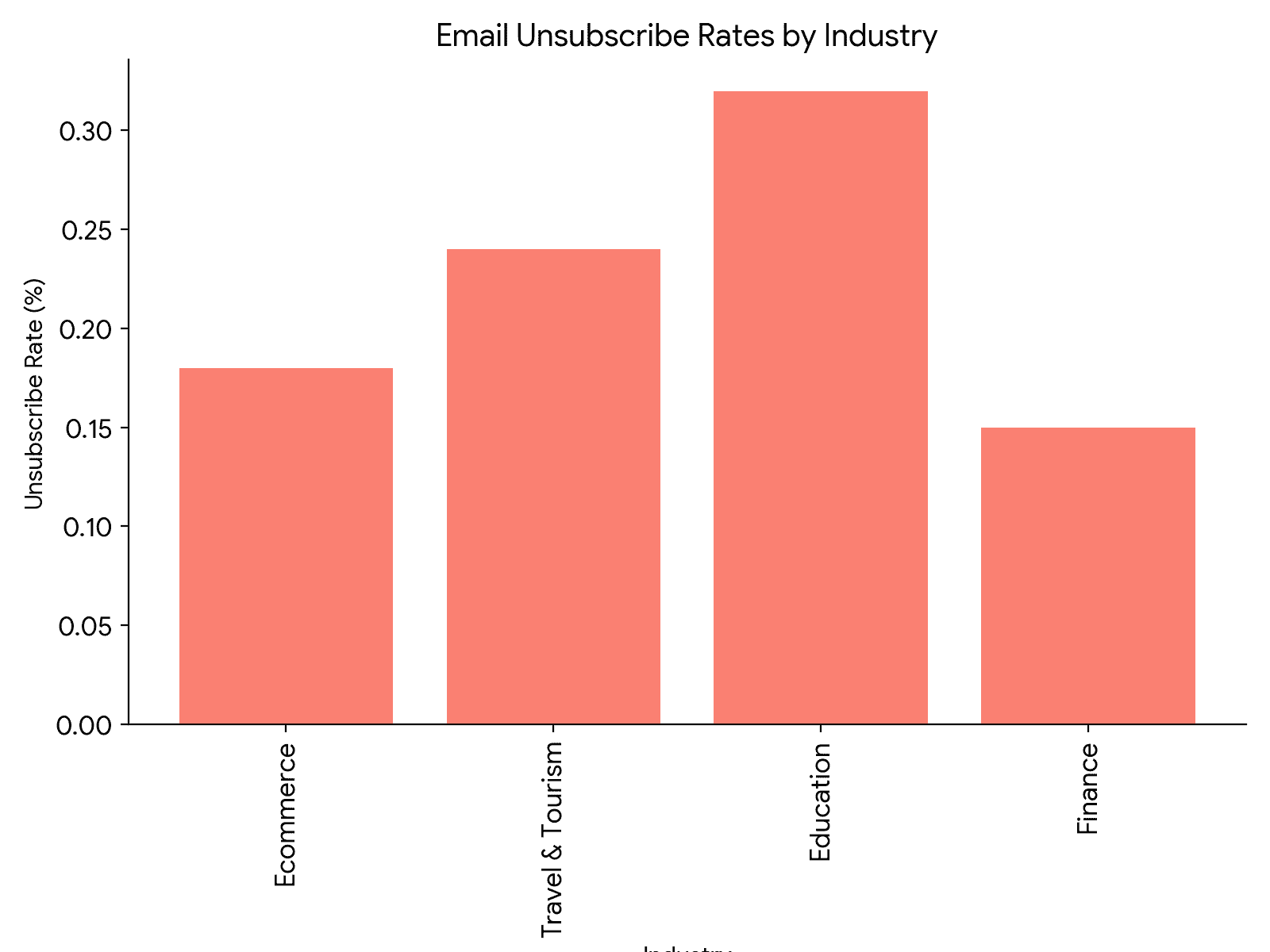
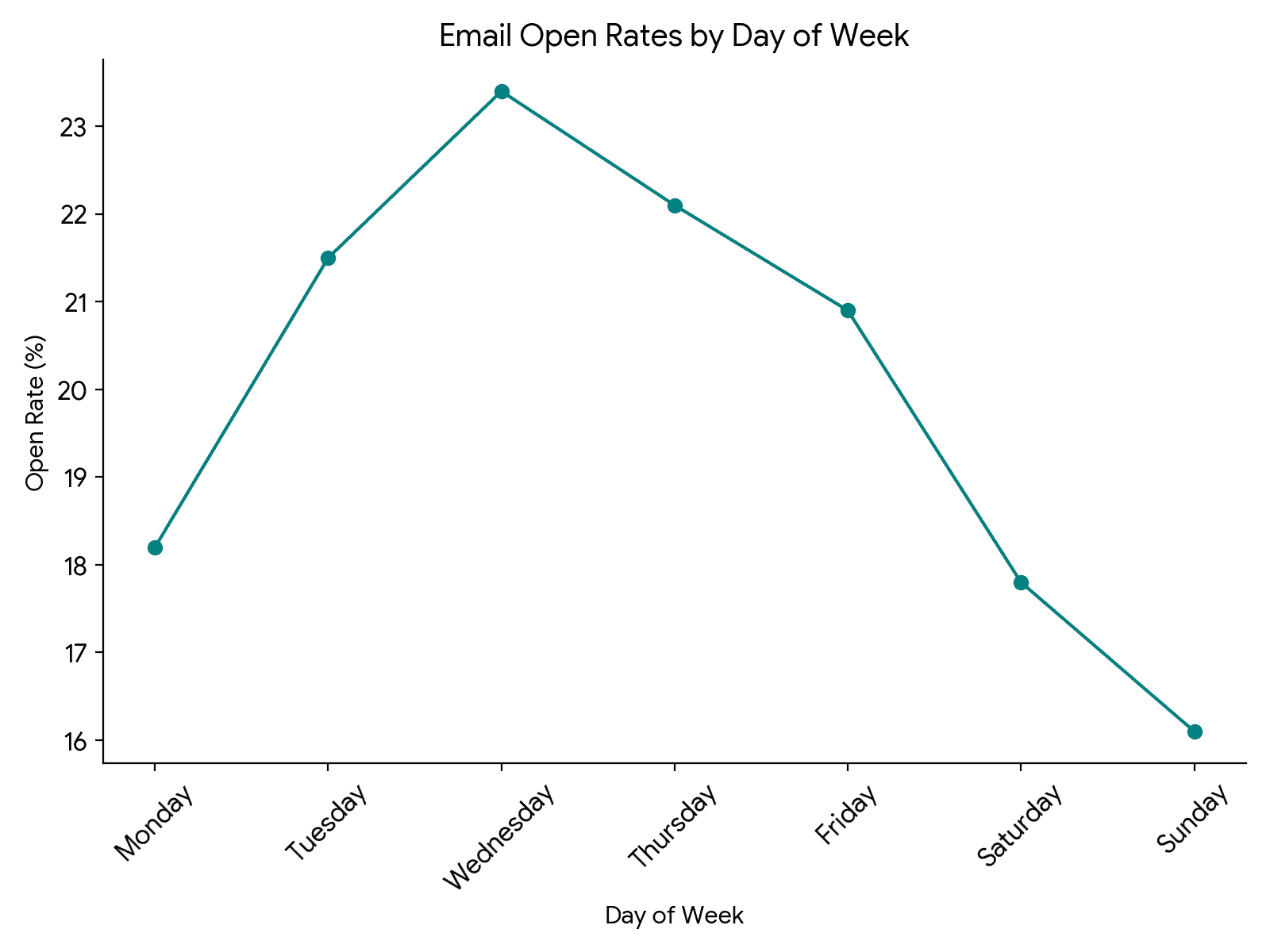
Understanding Open Rates, Click-Through Rates, and Conversions
Three key indicators will reveal how well your campaigns are resonating:
- Open rate shows how many subscribers opened your email. Industry averages range 15-25%.
- Click-through rate (CTR) shows how many who opened clicked your links. Good CTRs fall around 2-5%.
- Conversions track email-driven sales, sign-ups, downloads, or other goals reached.
Benchmark against past performance and optimize to increase these metrics over time.
Tools for Tracking and Analyzing Email Campaign Performance
Robust email marketing platforms like MailChimp, HubSpot, and ConvertKit make performance tracking seamless. Look for:
- Intuitive campaign analytics dashboards
- Insights on opens, CTRs, and conversions
- Segmenting and filtering to dig into results
- A/B testing capabilities
Assess metrics for each campaign and list segment. Compare success by season, content type, special promotions, and more.
Fine-tune your visual content, calls-to-action, and personalization until you unlock your perfect email formula for stellar engagement and conversions.
Conclusion: Future Trends in Travel Email Marketing
The travel industry moves fast. As new technologies and capabilities emerge, progressive brands should stay ahead of the curve.
In the near future, we may see more travel marketers:
- Tapping into artificial intelligence and machine learning to hyper-personalize messages
- Experimenting with interactive content like quizzes, calculators, and “choose your own adventure” emails
- Leveraging data from online and offline behavior for 360-degree customer views
- Getting creative with formats like gift guides, user-generated content, and mini magazines
- Optimizing for mobile with vertical orientation, simplified navigation, and bold visuals
The possibilities are endless. At the end of the day, customers want to feel understood and inspired. By delivering outstanding experiences through email, travel brands can build loyal followings that drive repeat visits and referrals for years to come.
Which innovations will shape the future of travel email marketing? Time will tell - but the most agile, customer-focused brands are sure to come out on top.
FAQ
What are some best practices for selecting compelling images to use in travel email campaigns?
Stunning visuals are critical for capturing attention in travel emails. Look for aspirational, high-quality photographs of destinations that spark wanderlust. Hero images should transport readers to alluring locations and highlight activities like exploring epic landscapes or relaxing at a luxury resort. Prioritize pictures with bright colors and crisp details. Timely imagery, like a snowy mountain peak in a winter ski promotion, helps reinforce seasonal themes.
Opt for a consistent look and feel across visuals for your brand. Provide descriptive captions and supplemental graphics like maps to orient readers. Make sure images are properly formatted and sized for your templates and optimized for both desktop and mobile. Track engagement on emails with especially compelling visuals so you know which images and styles resonate most with your audience.
How can I craft impactful subject lines for travel promotions?
Compelling subject lines entice subscribers to open your email and engage with the content inside. For travel, leverage seasonal dates, events, or destinations to grab attention - like “Cyber Week Deals on Aspen Ski Trips!” Use reader first names or personalization around past interactions to enhance relevancy. Ask questions to spark curiosity. For example: “Craving a beach getaway, Susan?”
Keep subjects short, specific, and scannable. Clearly convey your value proposition like savings or exclusive offers. Test different subject line variations across customer segments to see which drive the highest open rates, then refine based on learnings. Avoid overused phrases and be distinctive. Enable previews with preview text that gives readers a sampling of content. With compelling, personalized subject lines, you can dramatically boost opens.
What are some innovative ways to make travel emails interactive and engaging?
Static email blasts have fading appeal. Clever interactivity keeps readers captivated. Try adding polls and surveys to invite feedback on dream destinations or travel preferences. Embed quizzes customers can take to reveal ideal trips aligned to their interests. Provide calculators, like for converting points to miles, that deliver personalized results.
Another tactic is choose-your-own-adventure emails, where readers select an option to navigate to a tailored email branch. Allow subscribers to easily customize and book their own trip package right from the email. Insert clickable image galleries and carousels to let customers visually explore. Share fun soundbites, mini videos, or animations transporting readers to far-flung locales worldwide. With creative, interactive elements, you give customers an enticing taste of adventures ahead.
What strategies can help ensure my travel emails render well across devices?
Optimize for mobile readers by simplifying navigation, using large fonts, and dividing long blocks of text for quick mobile skimming. Avoid horizontal scroll on smartphones with narrow column widths. Remove unnecessary elements and make key destinations or buttons prominently “click to book.”
Leverage tools like Litmus to preview travel email renderings on mobile, tablet, and desktop screens. Audit your template’s mobile responsiveness and troubleshoot formatting issues. Limit large image file sizes that may load slowly on spotty connections. Use a mobile-first design approach with desktop enhancements added after. Follow best practices like single-column layouts, prominent calls-to-action, and sufficient white space. With a mobile mindset, you’ll engage readers anytime, anywhere.
How can I measure the ROI of my travel email campaigns?
Several key metrics indicate email marketing success for travel brands. Start by tracking open and click-through rates to gauge message resonance. Monitor how often your emails directly generate sales like package bookings or converting newsletter sign-ups. Tie revenues driven specifically from links in emails back to campaign costs for true return on investment (ROI).
Dig deeper by reviewing performance by customer segment, season, message topic, special promotions, and other filters to find what’s working. Conduct A/B split testing to refine your approaches. Share results with internal teams and leadership to showcase value. With consistent performance tracking, you can continually optimize travel email tactics to maximize ROI over time.
What emerging email marketing capabilities should travel brands consider leveraging?
Keep pace with email innovations to deepen subscriber relationships. Interactive content and messaging apps blend email convenience with modern chat interfaces. Consider conversational experiences or two-way messaging for trip planning dialogues. Experiment with artificial intelligence to generate hyper-personalized emails automatically.
Explore dynamic content that updates in real time with flight statuses, custom weather forecasts, or local language translations. Mobile wallet passes can provide last-minute travel reminders and contactless experience updates. Curate interactive travel guides and mini magazines subscribers can digitally flip through. Stay on the cutting edge with immersive emails including everything from VR to AR. The possibilities are nearly endless for the future of travel email engagement.
How frequently should I send travel promotion emails to avoid oversaturation?
Avoid inundating customers with a barrage of travel emails that may overwhelm or annoy. As a general rule, aim to email top customers who have booked or engaged most recently no more than 2-3 times per month. For general subscriber lists, 1-2 times per month is a good range. Always consider email relevancy over quantity.
Personalize based on past interactions so emails feel targeted rather than spammy. Ensure a good mix of informational content and special deals versus pure advertising. Give subscribers easy unsubscribe options but also reminders of the value your emails provide. Monitor for signs of disengagement like surging opt-outs or declining open rates. Adjust frequency as needed, and use customer feedback surveys to guide ideal cadence.
What are some strategies for aligning my editorial calendar to seasonal travel trends?
Review past performance data to spot recurring seasonal spikes in travel bookings and engagement on your site. Identify themes that resonate during winter, spring, summer and fall travel. Build promotable packages, deals and content tailored to each high-demand period. For winter, emphasize ski trips, warm getaways and holiday offers. Feature spring break and summer vacation packages in the warmer months.
Plan your email calendar around major holidays, events and dates when interest is highest. Maintain balance across seasons rather than overload on summer for example. Consider both local seasonal patterns along with global trends in traveler behavior. Promote ahead of popular booking periods while deals are top of mind. With timing aligned to seasonal demand, open and conversion rates for your seasonal travel emails will continue reaching new heights.
How can I track the success of special promotional emails, like Cyber Monday travel deals?
Isolate results data specific to your limited-time travel promotions by creating dedicated email campaigns or unique links to track. Compare open and click-through rates to gauge initial email resonance. Monitor acquisition metrics like special deal page visits, travel package additions, and purchases to assess consumer response.
Review site analytics around the promotion dates to analyze traffic surges, revenues collected, and conversion jumps compared to previous periods. Survey email recipients shortly after the promotion wraps to gather direct feedback. Document total sales, bookings or other defined goals hit from the special offer email. Calculate the final incremental sales and profits achieved based on your campaign costs to prove the value. With segmented tracking, you can understand exactly how consumers react to promotional outreach for future optimization.
What tools can I use to simplify travel email personalization?
Several powerful email marketing and automation platforms now make personalized messaging scalable. Mailchimp and HubSpot both offer advanced segmentation options to group contacts. Use tags and custom fields to track relevant behaviors and attributes for targeted content. Insert merge tags to dynamically populate subscriber names, interests and other details in messages.
Leverage workflows and lifecycle messaging to automate relevant follow-ups based on actions customers take. Use A/B testing to refine approaches and maximize personalization impact. Integrate your email tool with your CRM for a comprehensive view of each contact. With the right technology stack enabling intelligent personalization, you can deepen engagement across every subscriber journey.



